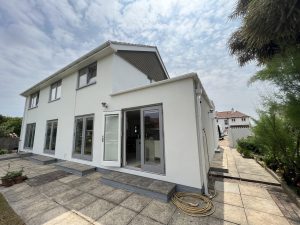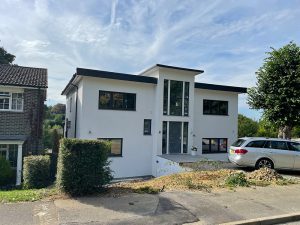Amidst the urban sprawl, as the din of daily life grows ever louder, the quest for tranquility within our living spaces becomes paramount. External Wall Insulation (EWI) is often lauded for its thermal efficiency; however, its acoustic benefits, though less heralded, are equally significant. EWI stands as a bulwark against the intrusive symphony of the city, offering residents not just warmth, but also the peace that comes with a quieter home.
Understanding Sound Transmission
Sound travels in waves, vibrating through air, liquids, and solids. When these waves encounter the walls of a building, they can either be absorbed, reflected, or transmitted through. Without adequate insulation, walls can act like diaphragms, picking up vibrations from the external environment and allowing them to permeate into our homes.
The Science of External Wall Sound Insulation for Noise
EWI systems serve as a form of mass-spring-mass insulation for noise. The insulating layer dampens sound waves, which lose energy as they pass through this spring-like medium, reducing the amplitude of the waves and hence the sound level. Materials commonly used in EWI, such as mineral wool or expanded polystyrene, are particularly effective; their porous structures disrupt sound pathways, diminishing the energy of the waves and the resultant sound.
Material Matters: Acoustic Properties of EWI
Different insulating materials offer varying degrees of sound reduction. Dense, fibrous materials like mineral wool are particularly adept at absorbing lower frequency sounds, which are typically the hardest to guard against. Rigid insulation boards, while excellent for thermal insulation, may require additional acoustic treatments to achieve the same level of external noise reduction.
Measuring the Impact of External Wall Sound Insulation: Decibel Drops
The efficacy of external wall sound insulation can be quantified in decibels (dB). Installing EWI can lead to a perceptible decrease in noise levels. For example, a reduction of just 10 dB can halve the perceived volume of sound, transforming a raucous street into a distant hum.
Real-World Applications: EWI in Urban Environments
Urban case studies reveal the transformative impact of insulation for noise. In city apartments exposed to relentless traffic noise, the introduction of EWI has resulted in significantly quieter interiors, enhancing the quality of life for residents. Such practical examples serve as a testament to the soundproofing capabilities of EWI.
Beyond Noise: Psychological and Health Benefits
The acoustic advantages of EWI extend beyond mere comfort. Noise pollution is a serious health hazard, implicated in causing stress, disrupting sleep, and even contributing to heart disease. By attenuating external noise, EWI contributes to the psychological and physical well-being of inhabitants.
Installation: The Key to Effective Insulation for Noise Reduction
The installation of EWI must be executed with precision. Gaps and thermal bridges can compromise its soundproofing effectiveness. The meticulous application ensures that the insulation not only performs optimally in thermal retention but also in noise reduction.
Complementary Strategies for Noise Wall Insulation
For enhanced insulation for noise, EWI can be part of a comprehensive approach, which might include double-glazing windows and using dense materials in the building’s construction. Such strategies, in concert with EWI, provide an integrated solution to noise pollution.
Looking to the Future: Innovations in Noise Wall Insulation
The future of EWI is poised for innovation, with materials being developed that offer greater external noise reduction, particularly in the challenging low-frequency range. Research is ongoing into new composites and structures that could revolutionise how buildings are insulated against sound.
Regulations and Standards
Building regulations increasingly recognise the importance of acoustic insulation. Standards are being set not just for thermal performance but for sound insulation as well, reflecting a holistic approach to the building envelope’s design.
Conclusion
The role of External Wall Insulation in noise reduction is multifaceted and profound. It not only enhances the thermal efficiency of buildings but also significantly improves the acoustic comfort of indoor environments. As urban density increases and the clamour of modern life grows louder, the silent sanctuary provided by noise wall insulation will be ever more appreciated, making it a key element in the design of serene, healthy, and sustainable living spaces.








